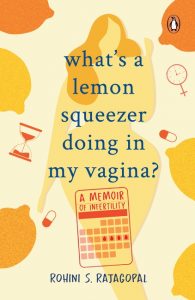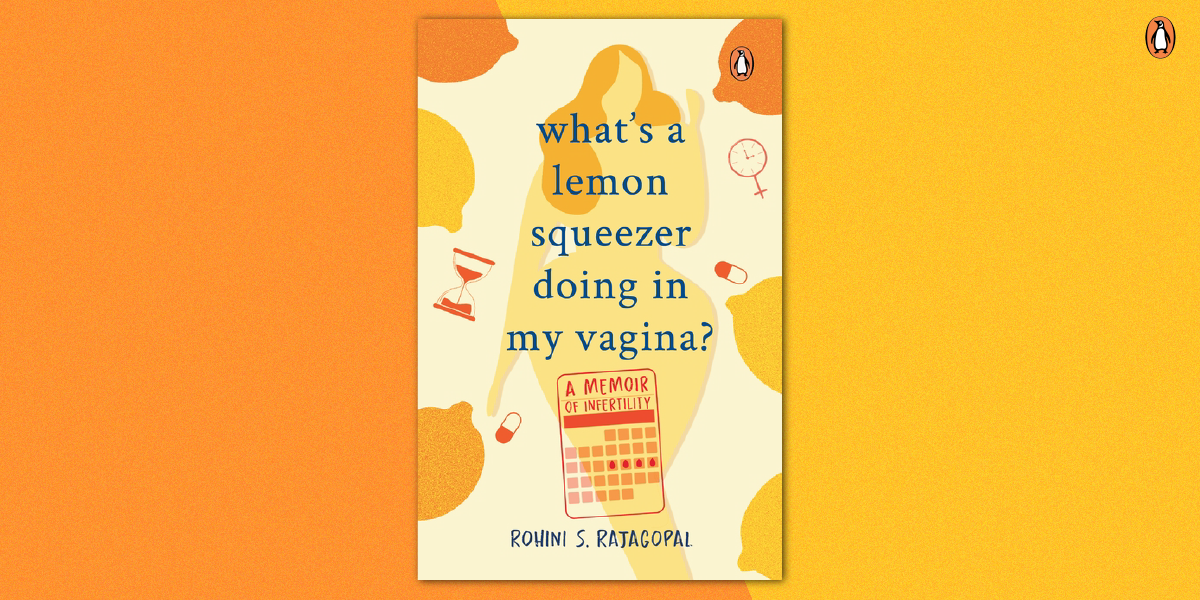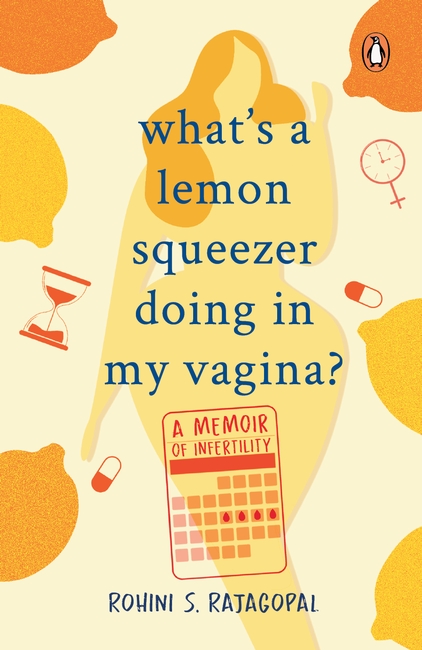Detailing the difficulty of undergoing infertility treatments, What’s a Lemon Squeezer Doing In My Vagina is a nuanced, heart-breaking and heart-warming work on the indignities of medical procedures, the precariousness of motherhood, and what this means to women. In this excerpt, Rohini Rajagopal talks about one of her Intrauterine insemination sessions.
~
I heard of ‘artificial insemination’ for the first time in a Malayalam movie when I was eight or nine years old. It was Malayalam cinema’s cult classic Dasharatham (1989), which was so ahead of its time that even now I am not sure if its time has come. A leading mainstream actor, Mohanlal, plays a rich, spoilt man-child who decides to act on a whim and have a child through surrogacy. He finds a desperate woman who needs money for her ailing footballer husband’s medical treatment and agrees to rent her womb. They draw up a contract, turn up for the procedure, and fifteen days later she is pregnant! No failed attempts, cancelled cycles or any other complications. With this movie lodged in my brain for reference, I thought fertility treatments were an easy-peasy lemon-squeezy affair. To be fair to the movie, it is not about infertility. It’s about a healthy, fertile couple who use artificial insemination for conception. It may well have happened that quickly and effortlessly in real life too. But the movie glosses over the unseemliness and hardships of the treatment. For those who have seen the movie, I hate to burst your bubble. Welcome to the world of ART.

I began our first IUI in July 2011 with the earnestness of a debutant, expecting early and prompt success… The procedure itself was relatively simple with only a few key steps. The first step was pills to stimulate my ovaries to release multiple eggs. The second was follicular study. Follicles are tiny fluid-filled balloons in the ovaries that function as the home of the egg. They may expand from the size of a sesame seed (2 millimetres) to the size of a large kidney bean (18 mm to 25 mm) during the course of the menstrual cycle, eventually bursting to push the egg out. The follicles are measured at regular intervals during a cycle to ascertain if they have matured and are ready to release the egg. This is done through a transvaginal ultrasound (TVS).
I was not a big fan of TVS. It involved insertion of a long, slim plastic probe into my vagina and twisting it around to get a close look at the uterus. Magnified images of the uterus appeared on a computer screen. I was appalled the first time when the doctor covered the transducer with a condom and dipped it in lubricating gel, indicating that it had to enter an orifice in my body. I thought that scans, by definition, were non-invasive. It caused some discomfort, but it was not very painful. Eventually, I learnt to relax my muscles and spread my legs far apart to make things easier. I wished I didn’t have to get a TVS, but if I had to then I could tolerate it.
The cycle got off on the wrong foot from the very beginning. The first ultrasound showed only one big-enough follicular blob (at 13 mm). The other four or five follicles were too small, indicating they might not reach maturity. This meant I might have only one egg despite taking drugs to stimulate the release of many.
…It was a busy day at the hospital for Dr Leela, who was swamped with several emergency C-sections. I sat alone in the deserted waiting hall of the IVF clinic, biding my time. Other patients had left after their ultrasounds in the morning. No one else was lined up for a procedure.
…Finally, at around one, Dr Leela came and apologized for the delay. I was taken to the operating room, asked to remove my leggings and empty my bladder. I lay down on the bed and pulled a sheet over my naked legs. A tray of surgical instrument kits was placed on a stand next to the bed. I kept my fingers crossed, hoping there would be no speculum.
Dr Leela began briskly tearing the kits open one by one and getting ready for action. When she pulled out the speculum, I lost my nerve. The thin mask of composure I was wearing until then crumbled. I sprang up and held back her hand desperately.
‘Please, don’t. I am scared.’
As soon as I said it, I regretted it. What was I thinking? It was a meaningless request. And Dr Leela had no patience for such trembling and dithering. She was not known to offer empty, placatory words, ‘It’s okay. Just relax. It will not hurt you.’ My protest was an annoying interruption and she reacted sternly.
‘Take your hand off. I don’t need it here.’
The room became tense.
…The ninety seconds it must have taken to fix the speculum and inject the semen were excruciating, and not just because of the physical hostility of the act. Not just because it felt raw or sore or I was bleeding. But because it was a breach of my already fragile self. It tore through the membranes of my defences, leaving me exposed and helpless.
In a few minutes, it was over and the doctor left. The stainless-steel tools were taken out by the nurses. The housekeeping staff cleaned the floor. The room became empty again. The pounding in my heart ceased. I rested in the metallic stillness of the operating room for thirty minutes, drove home, ate my lunch and went to sleep.
That IUI was an eye-and-mind-opener of the path ahead. An IVF clinic is a cold place to walk into. It doesn’t matter which IVF clinic you go to. There might be a difference in degree, but the air is still chilly and biting. You must shed your inhibitions, modesty and fears quickly because the most crucial part of fertility treatment involves lying on your back, knees bent, legs wide open, while probes, catheters and lemon squeezers are thrust inside your vagina by professionals whose day job this is. What you need is the stance of a warrior, not the long-suffering bearing of a patient.
~
Years later, I am just a few weeks away from going into labour. Ranjith’s mother and I are alone at home. We are having a woman-to-woman conversation about the trials and tribulations of bringing a human into this world. We discuss pregnancy scans and the improvements in technology since her time. She speaks about her own repulsion and discomfort during an internal examination, which was necessary in her days when ultrasounds were not as prevalent.
She asks casually, only half-asking, but mostly reconfirming, ‘You’ve never had an internal examination, alle?’
I gasp and mumble something to the effect of, ‘Yes, I have.’ But the truth is, there was no short answer to that question.
~
What’s a Lemon Squeezer Doing In My Vagina opens up a discussion that we are hardly willing to have, sensitising us to the physical and emotional toll that medical procedures and social scrutiny take on women.











